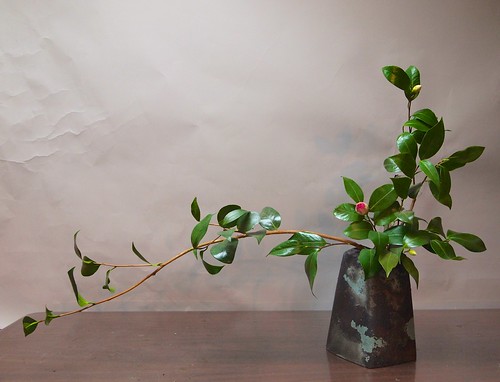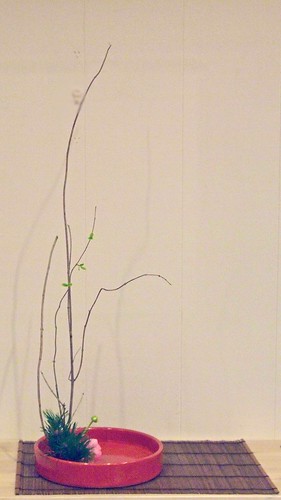Today, as I was going through some old papers, I found a sheet with notes from a lecture with
Dr. Nancy Stalker, from her visit in Oslo last year. Dr. Stalker is a professor of Japanese history and culture at the
University of Texas at Austin. One of her present research topics is the role of ikebana in constructing national and international Japanese identity in the twentieth century, especially focusing on its rapid expansion in postwar Japan from the 1950s-70s.
DR. Stalker states that Ikebana played an important role in the postwar recovery of Japan. The new Japan was branded as a nation balancing industrial "hard power" with artistic "soft power". In this marketing as a nation of culture, ikebana became a pillar of cultural nationalism. A state agency
Ikebana Geijutsu kyôkai (Japan Ikebana Association), was established to coordinate and encourage the development of the schools. About 110 schools joined the agency, that came to work almost like a cartel dominated by the three largest schools,
Ikenobo,
Ohara and the new and rapidly growing
Sogetsu school.
 |
| The Sogetsu Kaikan building 1958, designed by Tange Kenzo. |
Another interesting point is how the
iemoto system (head master hierarki of a school of traditional Japanese art) was challenged by this development. The iemotos that adopted the new organizational strategies, including new nationalism and gender ideas, saw their schools growing as they joined forces with the new cultural mega industry. Teaching ikebana became a new career opportunity especially for women, and it was said that if you had 40 students you could afford the life style of a white collar. In the 1960s there were 10 million ikebana practitioners. The number of schools grew to over 3000 in Japan, and the top three schools only had over 1 million students. In the
Edo period (until late 1800s) few schools had more than 1000 students, with the exception of Ikenobo that possibly had up to 10.000. The iemoto hierarki was developed in the late 16th to early 17th century. Before that the teachers were independent.
The iemoto system was challenged also by the growth of ikebana outside of Japan. In the 1960s approximately 10.000 foreign women held ikebana teachers exams from different schools and were teaching around the world. The organisation
Ikebana international was founded 1956 by Ellen Gordon Allen. Ikebana international organizes people interested in ikebana from different schools and encourages exchange between the traditions, a totally unthinkable idea within the iemoto system. Traditionally you work towards the perfection of your skills within your own school, following the rules set up by the iemoto. With a forceful personality and many colorful friends, Ellen Gordon Allen managed to develop a strong organisation and her ideas forced the schools to transform the traditions towards more openness. The iemotos realized that they could profit from adjusting to a more international approach.
































